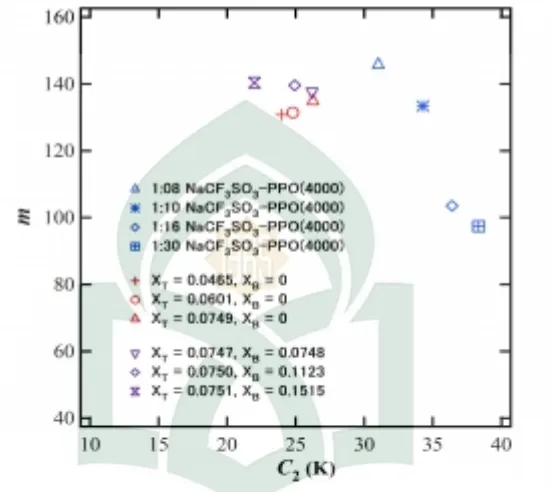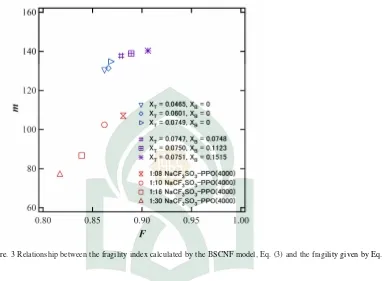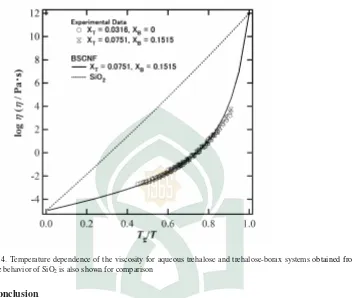A THEORETICAL ANALYSIS OF PHYSICAL PROPERTIES OF
AQUEOUS TREHALOSE WITH BORAX
SAHARA
Department of Physics, Graduate School of Science and Technology, Kumamoto University, Kurokami 2-39-1, Kumamoto, 860-8555, Japan.
Department of Physics, Faculty of Science and Technology, State Islamic University (UIN) Alauddin, Makassar, Indonesia.
MASARU ANIYA
Department of Physics, Graduate School of Science and Technology, Kumamoto University, Kurokami 2-39-1, Kumamoto, 860-8555, Japan.
The temperature and composition dependence of the viscosity of aqueous trehalose and aqueous trehalose-borax mixtures has been investigated by means of the Bond Strength-Coordination Number Fluctuation (BSCNF) model. The result indicates that the variation in the fragility of the system is very small in the composition range analyzed. The values of the materials parameters determined are consistent with those of the trehalose-water-lithium iodide system which were analyzed in a previous study. Based on the analysis of the obtained parameters of the BSCNF model, the physical interpretation of the WLF parameters reported in a previous study is reconfirmed.
1. Introduction
Trehalose is well-known for its ability to preserve life in cells, organisms, and biomolecules under conditions of low temperatures. Therefore, the effect of salt and other chemicals in trehalose solutions provides an interesting field of study from both, academic and applied science point of views. Experimental studies have shown that NaCl in aqueous trehalose mixtures is fully dissociated close to the glass transition temperature [1]. With the objective to gain further understanding on the properties of aqueous trehalose doped with salt and other chemicals, we have studied the viscosity behavior of these systems by using the Bond Strength-Coordination Number Fluctuation (BSCNF) model.
In a previous study, we have analyzed the temperature dependence of the viscosity in disaccharide solutions such as trehalose, maltose and sucrose [2]. The result revealed that these systems are fragile system. We have also analyzed the viscosity behavior of trehalose-water-lithium iodide system. This system is interesting from the point of view of ionic conduction, because the ionic conductivity of the system can be changed largely by controlling the chemical composition of the system [3, 4]. That is, it is expected that the optimization of the ionic conductivity could be searched by studying the viscosity-conductivity relation.
2. Model for the viscosity 2.1. The BSCNF model
In the BSCNF model, the melt is considered to be formed by an agglomeration of structural units. When the temperature of the system is lowered, the viscosity of the melt increases due to the increase of the connectivity between the structural units and the spatial distribution of the structural unit is frozen at the glass transition temperature Tg. According to the model, the viscous flow
occurs when the structural units move from one position to another by twisting or breaking the bonds connecting them. Each structural unit is bound to other structural units by certain bond strength [6].
Based on the above considerations, the temperature dependence of the viscosity has been written as
transition temperature, respectively. For their values we adopted the usual valuesη0= 10-5Pa·s and
ηTg= 1012Pa·s [7].Ccontains information about the total bond strength of the structural unit andB
gives its fluctuation. E0 and Z0 are the average values of the binding energy and coordination
number of the structural units, respectively.∆Eand∆Zare their fluctuations.Ris the gas constant. According to the BSCNF model, the fragility index m is written in terms of the parametersB
andCas [6, 8]
From Eq. (3), we can learn that a high value of the total bond strength of the structural unitCand a low value of its fluctuationBcorresponds to a less fragile system [9].
It has been shown that the quantitiesBandCare related by the following relation [8]
When
γ
1
, that is, when the ratio of the normalized bond strength fluctuation to the normalized coordination number fluctuation equals unity,the above Eq. (4) reproduces exactly the well known Vogel-Fulcher-Tammann behavior by choosing appropriately the values ofBandC[8].2.2. The WLF Equation
The WLF equation has been used widely to describe the temperature dependence of the viscosity and relaxation time in polymeric systems. It is an empirical equation and is given by
some reference temperature. In the above expression, we have used the glass transition temperature
Tgas the reference temperature.C1andC2are constants [10]. It has been reported that the values of C1 and C2 are 17.4 and 51.6 K respectively, for many materials [10, 11]. In terms of the WLF
parameters, the fragility is given by [11]
g
3. Results and Discussion
The BSCNF model and the WLF equation have been applied for the investigation of the temperature dependence of the viscosity of aqueous trehalose and aqueous trehalose-borax systems. In our study, the experimental data of the viscosity of aqueous trehalose-borax at nominal trehalose mole fraction,XT, of 0.075 and boron mole fraction,XBbetween zero and 0.1515 are used as test
materials [12]. From a fitting of Eq. (1) to the experimental data, we have determined the values of the parameters B and C corresponding to BSCNF model. Concerning the value of the fragility indexmandF, we have determined them from Eq. (3) and Eq. (7), respectively. The results of the analysis are summarized in Table. 1.
Table 1. Numerical values of the parameters of BSCNF model (B, C), and the WLF (C1,C2)
equation [12]. The experimental values of the glass transition temperature Tg, and the
fragility indexFandmfor various trehalose-borax solutions are also given.
XT: 0.0749, XB: 0.0597 0.792 9.96 14.87 24.10 213.3 0.89 141.04
XT: 0.0747, XB: 0.0748 0.789 10.61 14.91 26.19 216.9 0.88 137.72
XT: 0.0750, XB: 0.1123 0.790 10.03 14.70 24.93 224.7 0.89 139.57
XT: 0.0751, XB: 0.1515 0.791 9.97 14.15 22.01 233.8 0.91 140.36
The relation between the parametersBand Cof the BSCNF model obtained for different materials is shown in Fig. 1.The results for aqueous trehalose and aqueous trehalose-borax systems are shown in colored symbols. Due to the small variation in the composition range analyzed, the relation seems almost overlapping. In any way, for further understanding of the effect of addition of trehalose or borax in the solutions, the composition range should be extended. This is important, because the ionic conductivity of the trehalose system can be changed largely by controlling the chemical composition of the system [3, 4].
Figure 1. Relationship between the values of parametersBandCdetermined for different materials [13]. Red and violet symbols represent the parameters of aqueous trehalose and aqueous trehalose-borax systems, respectively.
system. Analysis based on the BSCNF model indicates that the relation betweenBandCdepends on the value ofδ[13]. The figure indicates that the systems in consideration is described by Eq. (4) by adopting the value ofδ=ln (ηTg/η0)=80.
Figure 2. Relationship between the fragility calculated from the BSCNF model, Eq. (3) and the value of the parameterC2
in the WLF equation.
In a previous study we have suggested that the BSCNF model could provide a physical interpretation to the empirical parameter C2 of the WLF equation. Here, such a suggestion is
considered for the case of aqueous trehalose-borax system. A comparison between C2 and the
fragility index described by the BSCNF model is shown in Fig. 2. For the case of polymer systems, it has been shown thatmdecreases with the increase ofC2[5]. For the case of aqueous
Figure. 3 Relationship between the fragility index calculated by the BSCNF model, Eq. (3) and the fragility given by Eq. (7).
Figure. 4. Temperature dependence of the viscosity for aqueous trehalose and trehalose-borax systems obtained from Eq. (1). The behavior of SiO2is also shown for comparison
4. Conclusion
The Bond Strength-Coordination Number Fluctuation (BSCNF) model and the WLF equation have been used to study the viscosity behavior of aqueous trehalose and trehalose-borax mixtures. The result indicates that both models describe well the temperature dependence of the viscosity reported experimentally. The analysis based on the BSCNF model suggests that the variation in the fragility is very small in the composition range analyzed. From the comparison of these models, it was shown that the BSCNF model could provide a physical interpretation to the empirical parameters used in the WLF equation.
Acknowledgments
Sahara acknowledges for the Monbukagakusho Scholarship.
References
1. D.P. Miller, P.B. Conrad, S. Fucito, H.R. Corti and J.J. de Pablo,J. Phys. Chem. B104, 10419 (2000).
2. Sahara and M. Aniya,Phys. Rep. Kumamoto Univ.13, 273 (2010).
4. R. Takekawa, Y. Iwai and J. Kawamura,Solid State Ionics: Fundamental Researches and Technological Applications, Chowdari BVR et al (ed), (Wuhan Univ Press, China, 2010), 463. 5. Sahara and M. Aniya,J. Solid State Electrochem, DOI 10.1007/s10008-012-1686-7 (2012). 6. M. Aniya,J. Therm. Anal. Calorim.69, 971 (2002).
7. L.M. Martinez and C.A. Angell,Nature410, 663 (2001). 8. M. Ikeda and M. Aniya,Materials3, 5246 (2010). 9. M. Aniya and T. Shinkawa,Mater Trans.48, 1793 (2007).
10. M.L. Williams, R.F. Landel and J.D. Ferry,J. Amer. Chem. Soc.77, 3701 (1955). 11. C.A. Angell, Polymer38, 6261 (1997).
![Table 1. Numerical values of the parameters of BSCNF model (B, C), and the WLF (C1, C2)equation [12]](https://thumb-ap.123doks.com/thumbv2/123dok/1703727.2080241/7.595.114.442.641.746/table-numerical-values-parameters-bscnf-model-wlf-equation.webp)
![Figure 1. Relationship between the values of parameters B and C determined for different materials [13]](https://thumb-ap.123doks.com/thumbv2/123dok/1703727.2080241/8.595.127.423.326.617/figure-relationship-values-parameters-b-determined-different-materials.webp)


